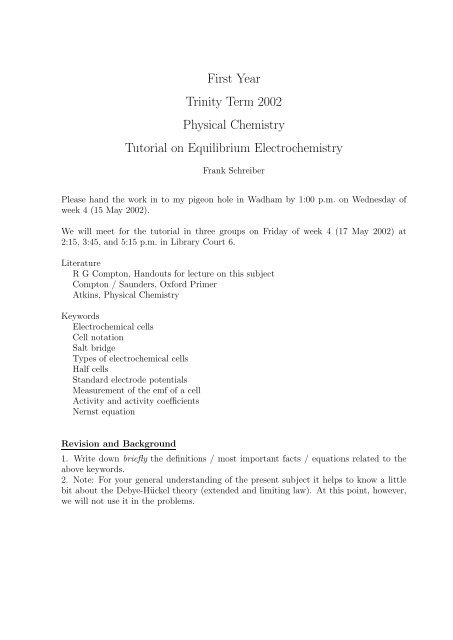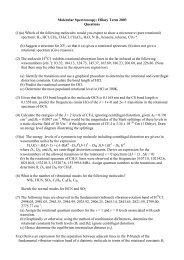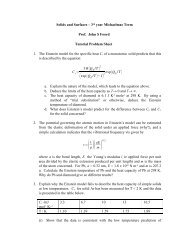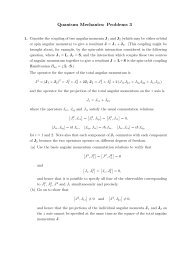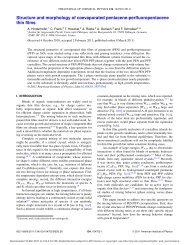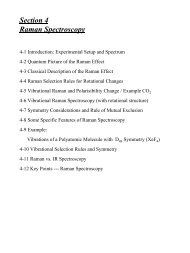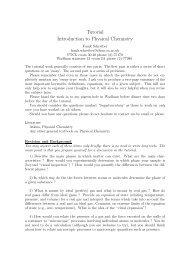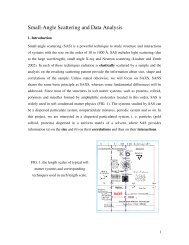First Year Trinity Term 2002 Physical Chemistry Tutorial on ...
First Year Trinity Term 2002 Physical Chemistry Tutorial on ...
First Year Trinity Term 2002 Physical Chemistry Tutorial on ...
You also want an ePaper? Increase the reach of your titles
YUMPU automatically turns print PDFs into web optimized ePapers that Google loves.
<str<strong>on</strong>g>First</str<strong>on</strong>g> <str<strong>on</strong>g>Year</str<strong>on</strong>g><br />
<str<strong>on</strong>g>Trinity</str<strong>on</strong>g> <str<strong>on</strong>g>Term</str<strong>on</strong>g> <str<strong>on</strong>g>2002</str<strong>on</strong>g><br />
<str<strong>on</strong>g>Physical</str<strong>on</strong>g> <str<strong>on</strong>g>Chemistry</str<strong>on</strong>g><br />
<str<strong>on</strong>g>Tutorial</str<strong>on</strong>g> <strong>on</strong> Equilibrium Electrochemistry<br />
Frank Schreiber<br />
Please hand the work in to my pige<strong>on</strong> hole in Wadham by 1:00 p.m. <strong>on</strong> Wednesday of<br />
week 4 (15 May <str<strong>on</strong>g>2002</str<strong>on</strong>g>).<br />
We will meet for the tutorial in three groups <strong>on</strong> Friday of week 4 (17 May <str<strong>on</strong>g>2002</str<strong>on</strong>g>) at<br />
2:15, 3:45, and 5:15 p.m. in Library Court 6.<br />
Literature<br />
R G Compt<strong>on</strong>, Handouts for lecture <strong>on</strong> this subject<br />
Compt<strong>on</strong> / Saunders, Oxford Primer<br />
Atkins, <str<strong>on</strong>g>Physical</str<strong>on</strong>g> <str<strong>on</strong>g>Chemistry</str<strong>on</strong>g><br />
Keywords<br />
Electrochemical cells<br />
Cell notati<strong>on</strong><br />
Salt bridge<br />
Types of electrochemical cells<br />
Half cells<br />
Standard electrode potentials<br />
Measurement of the emf of a cell<br />
Activity and activity coefficients<br />
Nernst equati<strong>on</strong><br />
Revisi<strong>on</strong> and Background<br />
1. Write down briefly the definiti<strong>on</strong>s / most important facts / equati<strong>on</strong>s related to the<br />
above keywords.<br />
2. Note: For your general understanding of the present subject it helps to know a little<br />
bit about the Debye-Hückel theory (extended and limiting law). At this point, however,<br />
we will not use it in the problems.
Problem 1 Equilibrium C<strong>on</strong>stants<br />
Calculate the equilibrium c<strong>on</strong>stants for the following reacti<strong>on</strong>s at 25 ◦ C in aqueous soluti<strong>on</strong>s.<br />
1. Sn + CuSO 4 (aq) ⇐⇒ Cu + SnSO 4 (aq)<br />
2. 2H 2 + O 2 ⇐⇒ 2H 2 O<br />
The standard electrode potentials (SEPs) are<br />
1/2 Sn 2+ + e − → 1/2 Sn −0.136 V<br />
1/2 Cu 2+ + e − → 1/2 Cu +0.337 V<br />
1/4 O 2 + H + + e − → 1/2 H 2 O −1.229 V<br />
Problem 2 Cell: Al | Al 3+ (aq) || Sn 4+ , Sn 2+ (aq) | Pt<br />
State or calculate at 25 ◦ C<br />
1. the half equati<strong>on</strong>s and the cell reacti<strong>on</strong><br />
2. the cell emf when all the c<strong>on</strong>centrati<strong>on</strong>s are 1.0 M and 0.1 M<br />
(ignore activity coefficients)<br />
3. ∆G 0 for the cell reacti<strong>on</strong> in (1.)<br />
4. the equilibrium c<strong>on</strong>stant, K, for the cell reacti<strong>on</strong> in (1.)<br />
5. the positive electrode and the directi<strong>on</strong> of electr<strong>on</strong> flow in an external circuit<br />
The SEPs are<br />
1/2 Sn 4+ + e − → 1/2 Sn 2+ +0.15 V<br />
1/3 Al 3+ + e − → 1/3 Al −1.66 V<br />
Problem 3 Cell: Ag| AgCl | Cl 2 (g) | Pt<br />
Solid AgCl c<strong>on</strong>ducts electricity sufficiently that the above cell is reversible with the AgCl<br />
either solid or liquid. The emf of the cell as a functi<strong>on</strong> of temperature is given below:<br />
T / K 573 623 673 723 773 823 873<br />
E / V 1.000 0.975 0.949 0.924 0.904 0.887 0.871<br />
Calculate the enthalpy and entropy of fusi<strong>on</strong> and the melting point of AgCl.
Problem 4 Cell: Ag| AgBr(sat.), 0.1 M KBr | AgBr, Ag<br />
The above cell is set up at 25 ◦ C. The saturated soluti<strong>on</strong> is made by dropping a little<br />
AgNO 3 into the KBr soluti<strong>on</strong>.<br />
1. Write an expressi<strong>on</strong> for the cell emf in terms of SEPs and c<strong>on</strong>centrati<strong>on</strong>s<br />
(ignore activity coefficients)<br />
2. The cell emf was measured as −0.3681 V. Find the solubility product of AgBr at<br />
this temperature<br />
The SEPs are<br />
AgBr + e − → Ag + Br −<br />
Ag + + e − → Ag<br />
−0.095 V<br />
+0.7991 V<br />
Problem 5 Cell Pt, H 2 (p 1 ) | HCl(m 1 ) | X | HCl(m 2 ) | H 2 (p 2 ), Pt<br />
For the above cell X indicates a salt bridge. At 25 ◦ C state or calculate<br />
1. an expressi<strong>on</strong> for the cell emf in terms of m 1 , m 2 , and p 1 , p 2<br />
(ignoring activity coefficients)<br />
2. the cell emf when m 2 = 0.2 M and m 1 = 0.1 M and p 1 = p 2 = 1 atm<br />
3. the cell emf when the hydrogen pressure in the RHS is increased to 10 atm, all other<br />
c<strong>on</strong>centrati<strong>on</strong>s remaining the same<br />
4. the cell reacti<strong>on</strong>
Problem 6 Harned Cell<br />
The emf of each of the following Harned cells is measured at two temperatures:<br />
H 2 (1 atm), Pt | HCl(10 −5 M) | AgCl | Ag E 1<br />
H 2 (1 atm), Pt | HA(10 −2 M), KA(10 −2 M) | AgCl | Ag E 2<br />
where HA is a weak acid and KA is its salt. The measurements give:<br />
293 K 303 K<br />
E 1 / V 0.820 0.806<br />
E 2 / V 0.878 0.866<br />
Calculate K a and ∆H 0 for the dissociati<strong>on</strong> of the weak acid, pointing out any assumpti<strong>on</strong>s<br />
you make. Comment <strong>on</strong> the results for ∆H 0 .<br />
Hints:<br />
1. You may assume in the sec<strong>on</strong>d cell that [HA] >> [H + ].<br />
2. Think carefully, in which case you need to use activity coefficients.<br />
Problem 7 Half Cells<br />
The standard electrode potentials of the following half cells are given<br />
I − | AgI(s), Ag(s)<br />
I − | I 2 (s)<br />
E = −0.152 V<br />
E = +0.536 V<br />
both at 298 K.<br />
1. Write the cell reacti<strong>on</strong> for a cell c<strong>on</strong>sisting of these two electrodes dipping into the<br />
same soluti<strong>on</strong> of iodide i<strong>on</strong>s (draw the cell to which your equati<strong>on</strong> refers).<br />
2. What is the emf of the cell when the substances are in their standard states ?<br />
3. The emf increases with temperature by 1.0 ×10 −4 V/K. Calculate ∆G 0 , ∆S 0 , and<br />
∆H 0 for the cell reacti<strong>on</strong> at 298 K.


